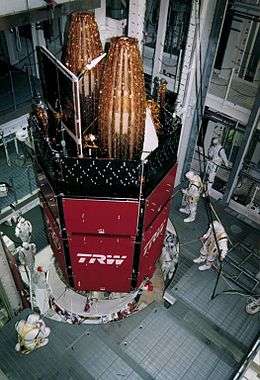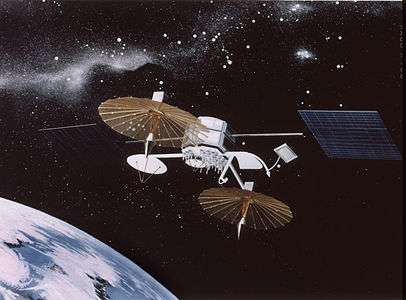TDRS-7
 TDRS-G before launch | |
| Mission type | Communication |
|---|---|
| Operator | NASA |
| COSPAR ID | 1995-035B |
| SATCAT no. |
23613 |
| Mission duration |
10 years (planned) 14+ years (achieved) |
| Spacecraft properties | |
| Manufacturer | TRW |
| Launch mass | 3,180 kilograms (7,010 lb)[1] |
| Start of mission | |
| Launch date | 13 July 1995, 13:41:55 UTC |
| Rocket |
Space Shuttle Discovery STS-70 / IUS |
| Launch site | Kennedy LC-39B |
| Orbital parameters | |
| Reference system | Geocentric |
| Regime | Geostationary |
| Longitude |
150° West (1995-1996) 171° West (1996-2003) 150.5° West (2004—?) 275.9° West |
| Perigee | 35,767 kilometers (22,225 mi) |
| Apogee | 35,803 kilometers (22,247 mi) |
| Inclination | 14.09 degrees |
| Epoch | 13 July 1995, 09:41:22 UTC[2] |
TDRS-7, known before launch as TDRS-G, is an American communications satellite which is operated by NASA as part of the Tracking and Data Relay Satellite System. It was constructed by TRW as a replacement for TDRS-B, which had been lost in the Challenger accident, and was the last first-generation TDRS satellite to be launched.
History
TDRS-7 is based on a custom satellite bus which was used for all seven first generation TDRS satellites.[3] Whilst similar to its predecessors, it differed from them slightly in that twelve G/H band (IEEE C band) transponders which had been included on the previous satellites were omitted.[4] It was the last communications satellite, other than amateur radio spacecraft, to be deployed by a Space Shuttle.
Launch

The TDRS-G satellite was deployed from Space Shuttle Discovery during the STS-70 mission in 1995. Discovery was launched from Kennedy Space Center Launch Complex 39B at 13:41:55 GMT on 13 July 1995.[5] TDRS-G was deployed from Discovery around six hours after launch, and was raised to geosynchronous orbit by means of an Inertial Upper Stage.[5]
Deployment
The twin-stage solid-propellent Inertial Upper Stage made two burns. The first stage burn occurred around an hour after deployment from Discovery, and placed the satellite into a geosynchronous transfer orbit. At 02:30 on 14 July it reached apogee, and the second stage fired, placing TDRS-G into geostationary orbit.[6] At this point it received its operational designation, TDRS-7. It was placed at a longitude 150 degrees West of the Greenwich Meridian, where it underwent on-orbit testing.
Semi-retired
In May 1996 it was moved to 171° West where it was stored as an in-orbit spare, and subsequently entered service.[7] In December 2003, it was relocated to 150.5° West.[8] It arrived the next month, and was returned to storage as a reserve satellite.
References
- ↑ "UCS Satellite Database". Union of Concerned Scientists. 2009-07-01. Retrieved 2009-08-09.
- ↑ "NASA - NSSDCA - Spacecraft - Trajectory Details". nssdc.gsfc.nasa.gov. Retrieved 2018-05-02.
- ↑ Krebs, Gunter. "TDRS 1, 2, 3, 4, 5, 6". Gunter's Space Page. Retrieved 2009-08-09.
- ↑ Krebs, Gunter. "TDRS 7". Gunter's Space Page. Retrieved 2009-08-09.
- 1 2 McDowell, Jonathan. "Launch Log". Jonathan's Space Page. Retrieved 2009-08-09.
- ↑ McDowell, Jonathan. "Index". Geostationary Orbit Catalog. Jonathan's Space Page. Retrieved 2009-08-09.
- ↑ "The TDRS-J satellite". Spaceflight Now. 2002-12-01. Retrieved 2009-08-09.
- ↑ "TDRS 7". TSE. Retrieved 2009-08-09.
